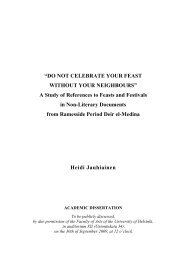BIA
bia51
bia51
You also want an ePaper? Increase the reach of your titles
YUMPU automatically turns print PDFs into web optimized ePapers that Google loves.
JANVIER 2015<br />
only one scratch is visible and its date of<br />
occurrence cannot be determined. It could have<br />
been made on the day of the mask’s discovery,<br />
during its first restoration in 1941, or more<br />
recently, in the last few months.”<br />
He said that upon its discovery inside the<br />
tomb in the Valley of the Kings on Luxor’s west<br />
bank, Tutankhamun’s mask was found in two<br />
pieces, resting on the mummy’s face. These<br />
pieces were the mask of the king’s face and<br />
the protruding beard.<br />
The mask and beard were transported to<br />
the Egyptian Museum in Cairo, where they were<br />
exhibited as two pieces in one showcase for<br />
almost two decades. In 1941, the objects were<br />
glued together as one piece, and in 1944 the<br />
beard was loosened and reattached.<br />
In August 2014, during repairs to the mask’s<br />
showcase, a worker accidently touched the<br />
beard and the beard was loosened again. “It<br />
was a regular accident,” ECKMANN said, adding<br />
that the beard had most probably come off<br />
because the glue used in 1941 had dried and<br />
was no longer effective.<br />
“Speaking as a conservator, believe me this<br />
case is very normal and it happens all of the<br />
time on objects not only in Egypt but all over<br />
the world,” ECKMANN said. He confirmed that<br />
restorers then glued the beard back on with<br />
epoxy resin.<br />
“I don’t know the kind of epoxy they used<br />
in the restoration. For that I would need to<br />
carry out a lab analysis,” ECKMANN said, adding<br />
that although epoxy is a material that can be<br />
legitimately used in restoration it is not the<br />
best solution. “Restoration has several schools,<br />
and I am from the school that prefers not to<br />
use epoxy in restoration,” he said. The glue<br />
was also applied improperly and remains were<br />
visible on the braided beard.<br />
“It can be reversed. It has to be done very<br />
carefully, but it is reversible,” said ECKMANN, who<br />
has been appointed by the Ministry of<br />
Antiquities to oversee the mask’s repair. He<br />
announced that a committee of experts<br />
consisting of conservators, archaeologists and<br />
natural scientists has been assigned to develop<br />
a plan for restoration of the mask.<br />
One museum conservator, who spoke on<br />
condition of anonymity, told the Weekly that<br />
epoxy is not a proper material to use to<br />
restore the mask, although it was a material<br />
often used to re-attach metal or stone because<br />
of its high strength. He said that the epoxy<br />
used had dried, leaving a gap between the<br />
face and the beard on the mask.<br />
al-Damâtî told reporters that the media had<br />
exaggerated the reports of damage to the<br />
mask. He claimed that a photograph used in<br />
the media had used Photoshop to change the<br />
shape of the mask and make the beard look<br />
damaged.<br />
The ministry had not attempted a cover-up,<br />
he said, contrary to what was reported in the<br />
newspapers. The restoration work carried out in<br />
2014 had been fully recorded, and in October<br />
2014 another restoration committee<br />
recommended the removal of some of the<br />
epoxy. “Tutankhamun is safe and sound, and<br />
all this brouhaha is unjustified. It has had a<br />
negative impact on Egypt’s reputation and its<br />
great desire to preserve and conserve its<br />
heritage,” al-Damâtî asserted.<br />
Egyptologist Monica Hanna described the<br />
restoration work carried out in August 2014 as<br />
unprofessional and told the Weekly that a<br />
scientific committee should have been<br />
appointed to select the best kind of resin to<br />
restore the artefact. “ECKMANN is a very<br />
professional conservator who restored king<br />
Pepi’s I statue,” Hanna said. There are other<br />
very skilful restorers, however, and the museum<br />
should have consulted them before attempting<br />
to restore the mask. “Why all that hurry to<br />
restore the mask in August 2014? Why use so<br />
much epoxy?” she asked. “Any artefact can<br />
need restoration, but the important thing is to<br />
restore it professionally.”<br />
The mask is 54 cm high and made of gold<br />
inlaid with coloured glass and semi-precious<br />
<strong>BIA</strong> LI — Janvier/Juin 2015 29



